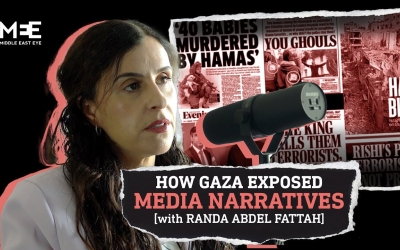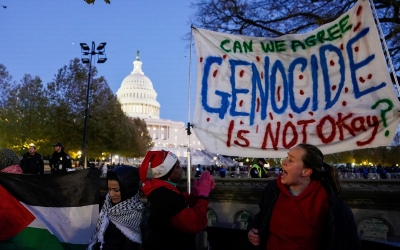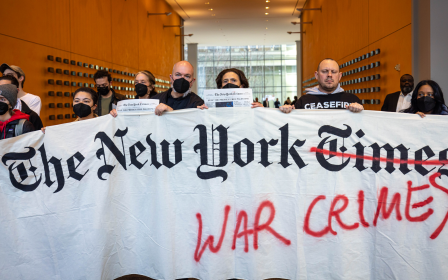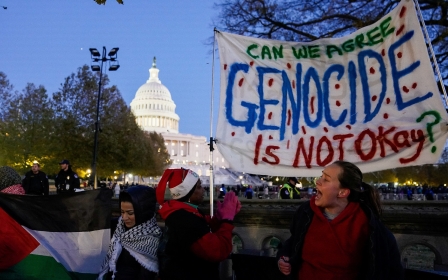Why the leaked New York Times Gaza memo is just the tip of the iceberg
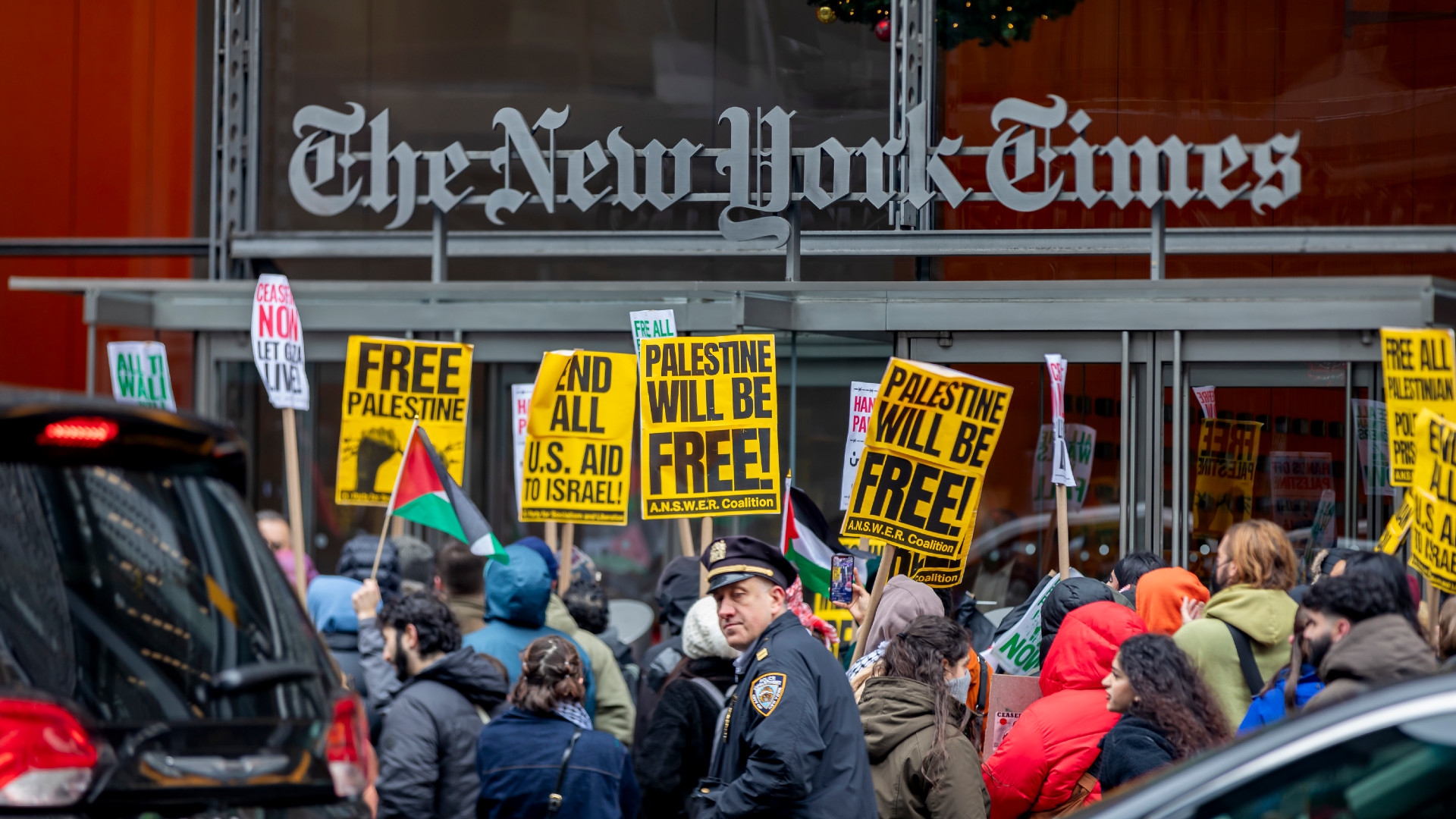
More than 20 years ago, journalism scholar Barbie Zelizer criticised The New York Times's pro-Israel bias and called on observers to challenge its "status as a newspaper of record on the Middle East".
Last week, The Intercept obtained a leaked New York Times memo suggesting that the paper instructed its reporting staff to avoid using terms such as "genocide", "ethnic cleansing", and "occupied territories" in its reporting on the ongoing Gaza war.
The leaked Times memo also instructs reporters to avoid using words like "slaughter" and "massacre" when describing Israeli-perpetrated violence against Palestinians.
This is serious journalistic malpractice - indeed, Israeli leaders have made ethnic cleansing an explicit goal, declared genocidal intent, and Israel has long illegally occupied Palestinian territory - but it doesn't come close to capturing the scale of The Times's pro-Israel, anti-Palestinian bias.
In December, The Times claimed to have uncovered a programme of systematic rape by Palestinian men who attacked Israel on 7 October. But the Times' investigation has since been thoroughly debunked, with the paper forced to scrap a planned related podcast.
Stay informed with MEE's newsletters
Sign up to get the latest alerts, insights and analysis, starting with Turkey Unpacked
Instead of investigating its own journalists for allegedly manipulating Israeli sources and producing a report that relied on false Israeli propaganda, The Times focused its attention on trying to find out which of its employees leaked information about the rape investigation.
But even all of this is just the tip of the proverbial iceberg.
There is significant scholarly literature about western media coverage of the Israel-Palestine conflict, with most of the empirical data serving as a damning indictment of western reportage.
But no outlet has been studied more - or come across looking worse in the data - than The New York Times.
Anti-Palestinian bias
In 2007, Richard Falk and Howard Friel, American scholars of international humanitarian law, wrote an entire book on how The Times "misreports" the Israel-Palestine conflict.
When both an Israeli and a Palestinian were killed on the same day, the Israeli death was usually mentioned first and was more likely to be the focus of the article
The researchers presented a plethora of data showing that the newspaper consistently privileges Israeli sources over Palestinian ones, ignores Israeli human rights abuses, and applies a double standard in its coverage of international law violations. They further argued that The Times "underreports the deaths and injuries of Palestinian Arabs" but "regularly and prominently publishes stories about Palestinians killing Israelis".
A 2009 study I published in the Journal of Middle East Media examining both The Times and The Chicago Tribune produced results consistent with those of Falk and Friel.
For example, my study, which employed quantitative content analysis, examined cruelty terms. They include words like "slaughter", "massacre", "butchered", and "savage", the kinds of words that The Times has recently been seeking to avoid, according to The Intercept report.
I found that the outlets used cruelty terms in 34 percent of articles that reported on Palestinians killing Israelis but in just eight percent of articles reporting on Israelis killing Palestinians.
Follow Middle East Eye's live coverage of the Israel-Palestine war
Additionally, my study found that Israeli violent deaths made the newspaper front page 60 percent of the time, compared with only 29 percent for Palestinian violent deaths.
Also, and importantly, when Israelis killed Palestinians, 40 percent of news articles buried the killing or death, not mentioning it until the news article's sixth paragraph or later. In contrast, 91 percent of the articles reporting on instances of Palestinians killing Israelis mentioned the killing or death within the first five paragraphs of the article.
I also found that when both an Israeli and a Palestinian were killed on the same day, the Israeli death was usually mentioned first and was more likely to be the focus of the article.
However, these two studies represent only a small portion of the research on The Times' coverage of Israel-Palestine.
In 2023, Holly Jackson used big data to show how The Times employs particular language, tone, and framing to privilege Israeli positions. Jackson used language processing software to quantitatively analyse more than 33,000 New York Times articles about Israel-Palestine.
She found that the Times was consistently much more likely to use violent language to describe Palestinians than Israelis even though Israel carried out significantly more violence during the study periods. Jackson's study also found that The New York Times was much more likely to use active voice for Israelis and passive voice for Palestinians.
Moreover, her sentiment analysis showed that the paper's tone was much more favourable to Israel than Palestinians, who were mostly covered with a "negative bias". Jackson also found that anti-Palestinian, pro-Israel biases increased rather than decreased over time.
'Overtly pro-Israel'
A host of studies - including the aforementioned work by Falk and Friel, as well as studies by Matt Viser, Mohammed Mosheer Amer, and Zelizer, among others - show that The Times uses far more Israeli sources than Palestinian sources.
For example, a 2002 study by US academics John Noakes and Karin Wilkins revealed that between 1984 and 1998, The Times sourced Israeli officials almost twice as often as Palestinian officials. Other studies have produced similar results.
The New York Times is apparently more pro-Israel than some Israeli outlets
The sourcing findings are significant, especially since media research shows that sources can often drive the frame, or slant, of news reports. They are also important in the context of US journalism, which relies inordinately on American officials.
American officials are already sufficiently pro-Israel, by and large. So when American papers rely more on Israeli sources than Palestinian sources, there is a doubling effect - American and Israeli sources combined far outnumber the relatively few Palestinian sources cited in news reports. By itself, this basic empirical reality explains much of the pro-Israel bias that persists at The Times.
But how pro-Israel is The New York Times, especially in comparison with other outlets?
Some evidence suggests that the paper is more pro-Israel than other pro-Israel newspapers in the US. Zelizer's 2002 study showed that the Times was more overtly pro-Israel than The Chicago Tribune and The Washington Post.
What's more, The Times is apparently more pro-Israel than some Israeli outlets.
A 2003 study by Viser showed that the Times was more pro-Israel than the Israeli paper Haaretz during three periods: the First Intifada (1987 - 1988); the Second Intifada (2000 - 2001); and post-9/11 attacks (2001 - 2002). Specifically, Viser found that The Times was more likely to depersonalise Palestinian deaths and rely heavily on Israeli sources, among other findings.
Some analyses - including a 2003 study by Susan Dente Ross and a 2009 study by Amer - have focused exclusively on New York Times editorial writing. In some ways, these studies have produced results that are even more damning.
Sourcing can automatically produce biases, as can other structural constraints on news production, and well-intentioned Times journalists may have produced pro-Israel bias unintentionally and without even knowing it.
But there may be more going on with The Times' editorial policies on Israel-Palestine.
The recent memo leak is concerning, but there are other, larger questions. Why, for instance, would The New York Times suddenly hire Anat Schwartz, one of the authors of the infamous, now-debunked rape investigation, and then immediately assign her to a critical, explosive investigation?
As Mondoweiss has reported, Schwartz is Israeli, has never worked as a reporter, and has a history of "liking" social media posts dehumanising Palestinians, including one about turning "Gaza into a slaughterhouse" and another which called Palestinians "human animals". Yet she was hired in October and immediately assigned to a major investigation.
While numerous other studies point to serious problems with The New York Times' reportage of other domestic and foreign policy issues, the paper arguably saves its worst performances for its coverage of Israel-Palestine.
Perhaps we all should have heeded Professor Zelizer's call to challenge The New York Times, way back in 2002.
The views expressed in this article belong to the author and do not necessarily reflect the editorial policy of Middle East Eye.
Middle East Eye delivers independent and unrivalled coverage and analysis of the Middle East, North Africa and beyond. To learn more about republishing this content and the associated fees, please fill out this form. More about MEE can be found here.



